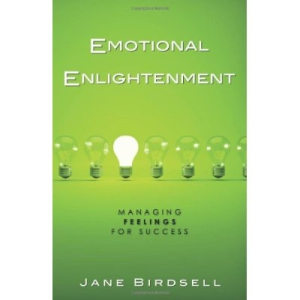Emotional Enlightenment
Managing Feelings for Success
In Emotional Enlightenment, Jane Birdsell states, “When you understand the thoughts and feelings of another person, you empathize with them.” The difficulty, she says, is that most of us have a hard time acknowledging our feelings.
Birdsell points out that such oft-repeated phrases as “wipe that smile off your face,” “cheer up,” and “be strong” are reminders to hide our feelings. She gives an example of a man who seems to dominate his wife: she withdraws during his angry spells, signaling that she expects to be overridden. Meanwhile, he is frustrated that she never says what’s on her mind, and so he continues to express himself in an angry manner. There is no safe space between them where they can both say what they feel and then modify their behavior accordingly. The results of these unexpressed feelings can be disastrous and can include all the physical symptoms of high stress.
The initial technique the author applies allows the reader to write down his or her own scenarios for dealing with feelings and altering behavior. Birdsell calls this the “ABC exercise.” She asks readers to consider a precipitating incident, to record the feelings the incident brought up, to explore the thoughts behind those feelings, and to imagine what he or she would likely do in the situation. Birdsell then asks readers to look at how they can change their behavior once they understand their feelings.
Readers, students, or clients then progress (often in a workshop format) to a deeper phase known as “the DESC script,” which connects the exercises to actual relationship situations: Describe the other person’s actions; express one’s feelings about that behavior; specify a change one would like to make in that behavior; and accept the consequences by agreeing to do something for the other person in exchange for the new behavior. The final goal of Birdsell’s method is to encourage empathy and good listening skills.
Birdsell is careful to state that her techniques are not appropriate for someone experiencing immediate, crushing grief, but her method can be helpful in dealing with long-term relationships and repeated unfruitful behaviors. She also acknowledges that she has been working on the book for fourteen years. In fact; only eight of the twenty-seven works cited in her reference list were published in 2005 or later. The relative staleness of her material could be a barrier for readers of the genre who are usually seeking the very latest developments in treatment.
Birdsell, a former public health nurse turned private counselor, uses her techniques in group settings and, presumably, on a one-to-one counseling basis. This small, well-organized book, illustrated with cartoons and some photographs, appears designed as an aid to her clients and an outreach to the general public.
Reviewed by
Barbara Bamberger Scott
Disclosure: This article is not an endorsement, but a review. The publisher of this book provided free copies of the book and paid a small fee to have their book reviewed by a professional reviewer. Foreword Reviews and Clarion Reviews make no guarantee that the publisher will receive a positive review. Foreword Magazine, Inc. is disclosing this in accordance with the Federal Trade Commission’s 16 CFR, Part 255.

